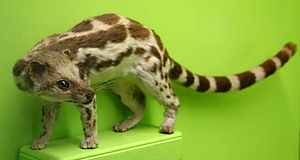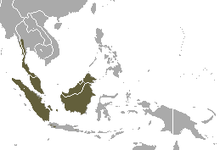Ribbon singing
| Ribbon singing | ||||||||||||
|---|---|---|---|---|---|---|---|---|---|---|---|---|

Ribbon Linsang ( Prionodon linsang ) |
||||||||||||
| Systematics | ||||||||||||
|
||||||||||||
| Scientific name | ||||||||||||
| Prionodon linsang | ||||||||||||
| ( Hardwicke , 1821) |
The ribbon linsang ( Prionodon linsang ) is a species of predator from the family of the linsangs (Prionodontidae) living in Southeast Asia .
features
Ribbon linsangs are slender, elongated animals with a long tail and long neck. Their short, soft fur is yellowish-white to white-gray in color, the name-giving feature are the five rows of black spots on the back, which are usually banded together. There are two wide, black stripes on the neck, the flanks and the outside of the upper arms and thighs are dotted. The tail is densely hairy and provided with seven to nine dark rings. The snout is pointed, the ears are rounded. The dentition is adapted to the cutting of meat and resembles a cat, the posterior molars have receded. The feet each have five toes that have retractable claws . Banded linsangs reach a head body length of 38 to 45 centimeters, the tail is only slightly shorter than the body with 33 to 38 centimeters. The weight is 0.6 to 0.8 kilograms, with the males being slightly larger than the females.
distribution and habitat
Bänderlinsangs live on the Malay Peninsula from the south of Myanmar and Thailand to the mainland part of Malaysia and on the islands of Sumatra , Borneo and Java including smaller offshore islands. Their habitat is primarily tropical rainforests , they can be found from sea level up to 2700 meters above sea level.
Way of life
These animals are predominantly nocturnal. They are good at climbing and often hang out in the trees, but sometimes they come to the ground while foraging. They sleep in nests that they build in tree hollows or hollow tree trunks above the ground and line with leaves. Little is known about their social behavior, they probably live solitary. The area is marked with urine and excrement, and they rub their shoulders, neck and flanks on objects to leave their scent marks.
They are carnivores and their diet includes rodents , lizards , frogs , birds and insects . Smaller prey animals are killed with one bite in the neck, larger ones with several bites in the head while being grabbed with the front paws.
Once a year the female gives birth to two young animals between February and August. These weigh around 40 grams at birth and are almost the same color as adults. After four months they are fully grown. While young males leave their mother after weaning, young females stay with her until sexual maturity has occurred. Life expectancy in human care can be over 10 years.
threat
It is not known to what extent banded linsangs can survive in partially deforested areas and secondary forests , so it is also uncertain how the deforestation will affect the populations of these animals. In the past the animals were hunted for their fur, today they are protected in a large part of their range. In some areas, the populations have declined, according to the IUCN , the species is widespread and not endangered.
literature
- Philippe Gaubert: Family Prionodontidae (Linsangs). In: Don E. Wilson, Russell A. Mittermeier (eds.): Handbook of the Mammals of the World. Volume 1: Carnivores. Lynx Edicions, 2009, ISBN 978-84-96553-49-1 , pp. 170-174.
- Ronald M. Nowak: Walker's Mammals of the World. The Johns Hopkins University Press, Baltimore 1999, ISBN 0-8018-5789-9 .
Web links
- Prionodon linsang onthe IUCN Red List of Threatened Species . Retrieved on June 28, 2009.
